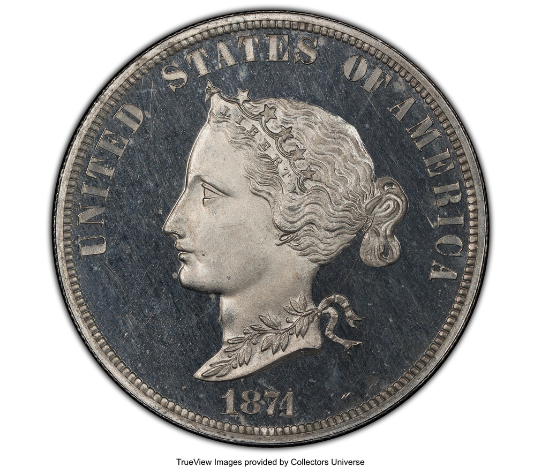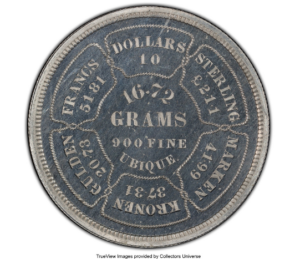
The 1874 Bickford Ten Dollar in Aluminum, PCGS PR66+CAM is the Professional Grading Service’s (PCGS) Coin of the Month.
There are hundreds of various notable U.S. coin patterns, but some take the cake when it comes to rarity and intrigue. The 1874 Bickford Ten Dollar in aluminum is one such piece, depicting a head of Miss Liberty on the obverse and various inscriptions on the reverse pertaining to the weight, value, and international monetary conversions of this proposed coin. It’s unlike most other emissions from the U.S. Mint, either regular-issue or pattern, and it offers the numismatic student a glimpse into some of the more novel creations once nearly positioned for official production.

The pattern was the brainchild of Dana Bickford, a Vermont knitting machine inventor who pitched this coin as the answer to an international trade coin of larger face value than the newfangled Trade dollar that had recently been put into service in 1873. While the pattern was ultimately never commissioned into work as a functioning trade coin, the fact that it got as far as pattern production is noteworthy in itself and offers another of many colorful chapters in the grander scheme of U.S. pattern coinage of that time.
Only two specimens are known and both trade for large sums, with one specimen sold in January 2022 for $108,000. The other – the finer of the two – was graded Proof-66+ Cameo by Professional Coin Grading Service and once belonged in the Harry W. Bass, Jr. Collection. It crossed the Heritage Auctions block for $264,000 in September 2022.
Coin Grading
Grade refers to a coin’s level of preservation: how many nicks or scratches or other imperfections it has. Coins are graded on a scale of one to 70, with higher numbers signifying higher grades. One represents a coin that is so well worn that it’s barely identifiable as to its type. 70 represents a perfect coin: a coin that when viewed under a five-power magnifying glass has no visible imperfections.
60 through 70 represent the Mint State (MS) grades. A coin graded MS-60 can have so many nicks and scratches and flaws that it might look as if Godzilla used it as a teething ring. MS-65 is the industry standard for “Gem.” MS-66 through MS-69 are near-flawless super-grade or wonder coin assignations. With each grade level above MS-66, the value might double or triple.
Grade names are used in addition to numerical grades. In ascending order, these word grades are About or Almost Good; Good; Very Good; Fine; Very Fine; Extra or Extremely Fine; About or Almost Uncirculated; and Mint State.
A Proof is not a special Mint State coin. Proof refers to a method of manufacture, not a grade. Although Proof coins are struck using specially polished dies and specially selected planchets (metal discs) to assure a chromium-like brilliance, they can circulate or be spent. Proofs are also graded on the one through 70 scale. A Proof coin grading less than Proof-60 is referred to as an “impaired Proof.”
To subscribe to COINage magazine click here.
















